#Journal of Historical Archaeology
Text
[While renovating the second story floor of the threshing room of his circa 1840's barn], the owner was surprised to see a red-orange card drift to the snow covered ground as he turned over one of the planks. The card […] had slipped from an enclosure made of a single sheet of folded lead, which had been nailed to the bottom of a floor plank [… where] the enclosure had been positioned directly above an overlapping floor joist in order to hide it from view. Three nails- possibly representing the Holy Trinity, emphasized in Braucherei […] had been used to secure the sheet of lead with the cryptic card inside, and these had come loose during the dismantling of the floor. As this was the original floor for the c. 1840 barn, it can be safely assumed that the concealment had been carefully placed between the flooring and the joist at the time of the building's erection […]
The blessing consists of a dull red-orange card composed of heavy, cold-pressed, cotton-rag cardstock, measuring [3 inches by 4 inches], with rounded corners. Three holes can be found on the document, marking where the three nails originally secured it within its lead enclosure. The majority of the text of the blessing is in the English language [… and] begins: '[H]elp success come to my barn and stock, horses and cows'. This line is followed by a line of cypher, composed of dashes, dots, grids, and curvilinear characters. A line of astrological symbols divides the card into an upper and a lower section. Below these symbols, another English phrase continues: 'Success and good health come to all of our stock'. This is followed by another grouping of cypher, consisting of slashes and diacritic points. This cypher is very important, as it identifies that the barn blessing is probably the work of a practitioner of folk magic, an individual who would have used such a personalized magical script to enhance the overall arcane appeal of the talisman, rather than barn builders or farmers taking matters into their own hands.
Excepting the cypher script, which is unknown and unintelligible to me, the astrological components of the charm are easily recognizable as notations found in common Pennsylvania Dutch agricultural almanacs contemporaneous with the time of the building of the barn itself. The symbols are, beginning on the left of the blessing and proceeding to the right, representative of the Moon, the Sun, the planet Saturn, the sextile and trine aspects, as well as a character resembling the Greek capital letter sigma, or a capital M turned 90° to the left. This latter character may have been a stylization or corruption of the symbol for Jupiter. A number of early Pennsylvania almanacs that potentially may have been used as a reference for early practitioners were produced in a typeface that featured an idiosyncratic or italicized character for Jupiter, such as in Der Neue Americanische Landwirthschafts-Calender (The New American Agricultural Calendar).
The symbols for the aspects, while simple and geometric in form, are slightly more advanced components of the almanac, symbolizing planetary alignments by degree. The sextile aspect indicates that two or more planets are located within the celestial sphere at increments of 60° (or 360° divided by six), according to tradition portending a positive aspect to human interactions for the duration of the alignment, resulting in what an early 19th-century almanac describes as '[g]ut Freundschaft machen', or, the making of good friends. Likewise, the trine aspect divides the celestial sphere into three, which places two or more heavenly bodies at 180° increments, and its trine nature is believed to represent a positive relation between humankind and divinity, or as one early 19th-century century almanac suggests, 'für gut Beten', a time when prayers are likely to be answered. It is unclear which of the four heavenly bodies depicted on the blessing, if any, were intended to correspond to the aspects.

From “The Concealment of Written Blessings in Pennsylvania Barns” by Patrick Donmoyer; available in the Manifestations of Magic: The Archaeology and Material Culture of Folk Religion edition of the Journal of Historical Archaeology - Volume 48, Number 03, published 2014 (My Ko-Fi Here)
#The Concealment of Written Blessings in Pennsylvania Barns#Patrick Donmoyer#Manifestations of Magic: The Archaeology and Material Culture of Folk Religion#Journal of Historical Archaeology#Volume 48 Number 03 2014#Quote#Pennsylvania Braucherei
2 notes
·
View notes
Text
hey hey guess what it's time for
Update 4: Return of the (Soap) King
For those who haven't been following along, I've been having a nice time doing experimental archaeology and recreating cosmetics/household goods that are historically plausible for local idiot pirate Stede Bonnet to have had around.
Figure 1. Me, addressing my kitchen appliances.

So far we've had successful lip balm, yet-to-be-completed Oil of Lavender, the terrible tragedies that have so far befallen the pearl face cream, and, finally, the unending journey of the one household item actually mentioned on the dang show: the lavender soap (with updates 1-3 and several mini-updates).
Did this all secretly derive from my researching period-appropriate medical horror? Yes. Am I still going to write about it? Of course come on now I can't just keep that enema information to myself--
But TODAY IS NOT THAT DAY.
Figure 2. One very excited ship's surgeon who will unfortunately have to bide his fuckin time.

Nope, today we're on the next iteration of the lavender soap, because we're still at the "fuck around and find out" portion of this experimental process-- and so, behold:
Version 3.0
7 oz. dried soap
4 oz. ground orrisroot
1 oz. ground whole cloves
1 oz. ground benjamin
10 drops lavender essential oil
oil of lavender, q.s.
rosewater, q.s.
You may notice that I have, tragically, only added enough of anything lavenderish to allow myself the honesty of still calling this "lavender" soap -- as previously discussed, lavender essential oils (as we know them today) were not really a Thing, and the Oil of Lavender (...which is not an essential oil, but rather an infusion of lavender flowers and olive oil) is not quite ready for primetime scent vibes, so I genuinely don't think these are comparable to actually just grinding up and shoving in the dried flowers.
But for the sake of Science, I needed to find out if removing the flowers would help with the browning issue of previous versions, so-- out went the lavender. For now.
Figure 3. Oh no, I-- oh man, don't cry, I'm sorry, I'll put it back omg.

Other changes in this version are:
store-bought ground orrisroot (...listen, Thomas is but a wee lad, and not yet hearty enough to wreck regular orrisroot as hard as it needs);
store-bought ground benzoin (because it was cheaper to buy in bulk that the solid resin from the woo-woo shop);
increased the amount of orrisroot from 1 ounce to 4 ounces, in keeping with some other recipes, to try and bulk up the myristic acid content (i.e., the thing wot makes olive-oil based Nabulsi soap actually produce a bubbly lather)
I should at this point say that typically the scientific process recommends making only one change at a time when conducting Experiments, so that one may know what exactly affected a change in a positive, negative, or neutral manner.
Consider, however, that I have no patience. So fuck it, we ball.
Show us the soap, trifles
To get to the soap, you must first suffer through mortifying ordeal of process photos.
Figure 4. The ground orrisroot on my tiny digital scale (that actually measures grains, which itself is a holdover from apothecary measurements!)
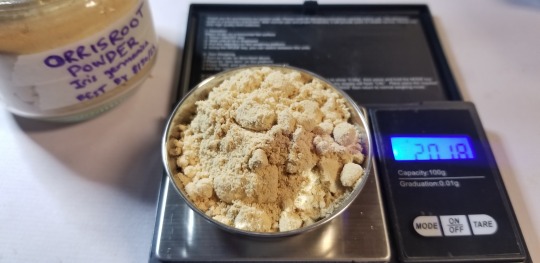
Wait wait wait actually look at my tiny bullshit scale, I love it, look at its little one-gram calibration weight:
Figure 5. A baby.

Figures 6 and 7. An ounce of whole cloves (left) and the results of young Thomas's efforts thrown on top of the orrisroot and benjamin in the mortar (right).

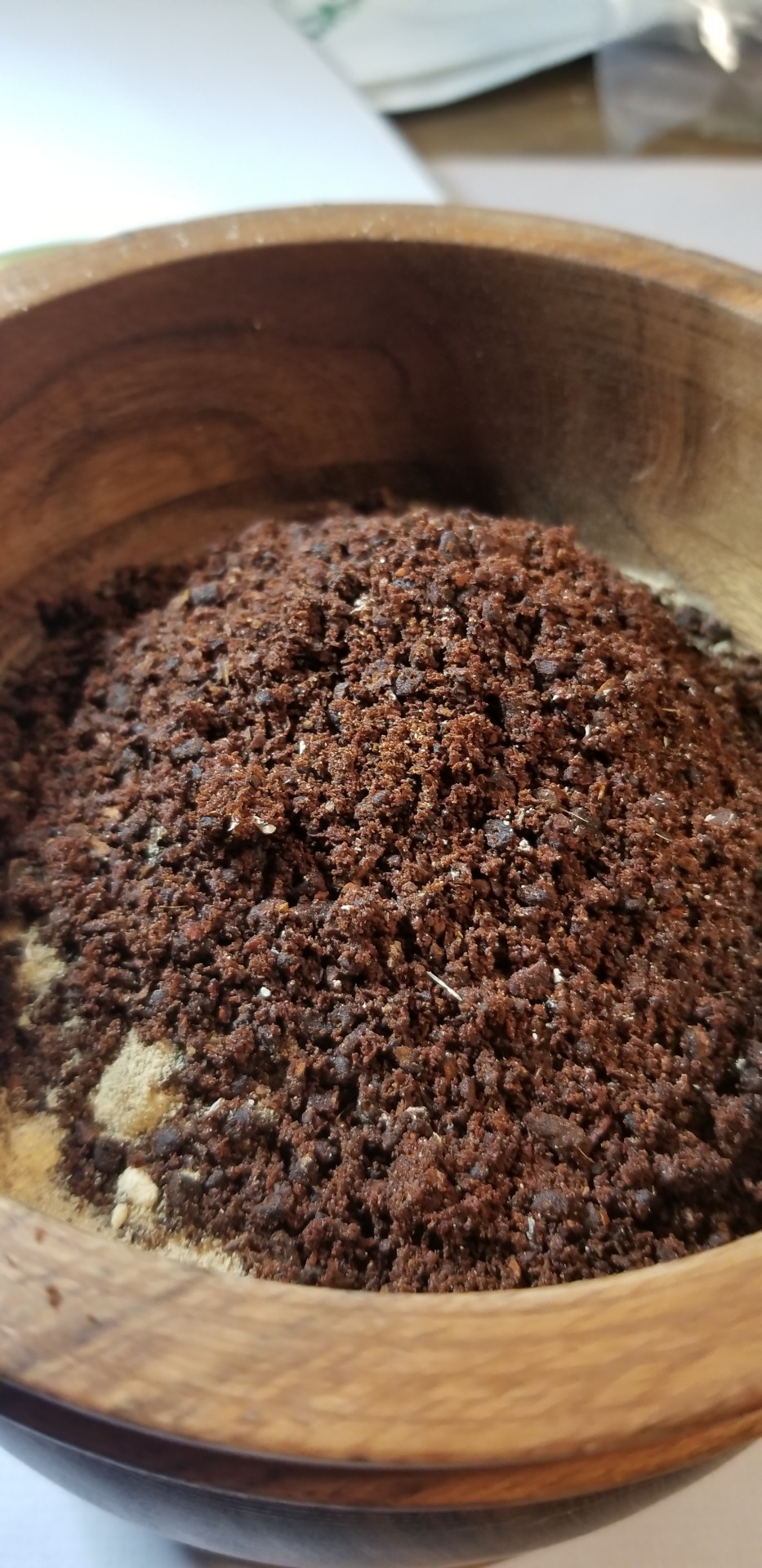
I should note that rather than grinding the cloves in my granite mortar and pestle first, I put them straight into Thomas's maw-- I don't know if that led to how intensely clove-oily these grounds are, or the fact that the lavender flowers were not present to soak it up. Previously I got a grey-green powder out of grinding the both together, so this rich, wet clove-color did not bode well for my "can I stop this from being brown?" soap plans...
Figure 8. ...Or maybe it'll be fine? I added the dried soap, and now look at them all mixed together!

As a note, I had to actually use a whisk at this point rather than just rely on my pestle to do the work -- my mortar is Too Small for these shenanigans, and the four ounces' worth of orrisroot did not help matters. I won't say how much of this mix ended up outside the mortar and on my clothes, but it was... it was a non-zero amount.
Whatever, thought I. This is Science. This is me experiencing the divine art of creation across space-time with my alchemical forebears, and also this is why I should not be allowed in other people's kitchens.
Notably, the upped powder content meant that I had to add a lot more splashes of rosewater to get to a dough-y state where the soap could be hand-rolled, and I had to work significantly longer with the pestle-- while version 2.0 was, per my notes, about 8-10 minutes' worth of work, I would call this a solid 20 minutes at least of beating the ever-loving shit outta this mix until everything was incorporated.
And once it was, well--
Figure 9. Hello, brown.
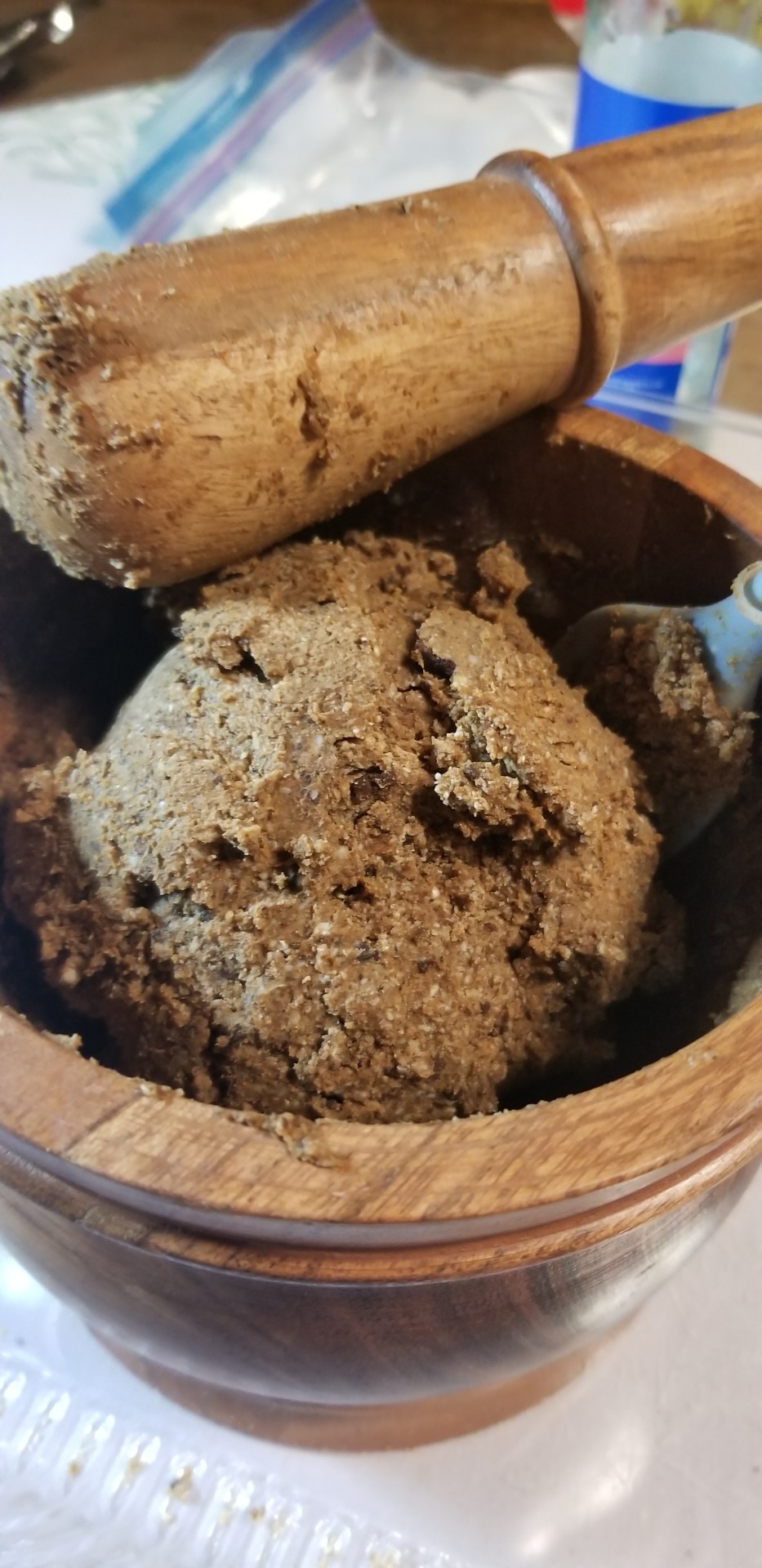
As you can see, the soap mix does form up very nicely, though it still requires a spatula to clear the sides of the mortar and pestle.
At this point, remembering that the last time I hand-rolled wash balls my palms came away Very Brown, I donned some latex gloves before I commenced my rolling. However, because (and again, I cannot stress this enough) I lack patience, I threw in another change: rather than leaving them as balls, I squished them slightly between my palms to flatten them into slightly more traditional soap shapes.
Figure 10. Cookie dough or falafel: you decide.

A note regarding the scent: Whether it's the relative lack of the lavender, or the big bump to the orrisroot (or some magic alchemical combination of the two), the soaps, while still smelling strongly like spice cookies, now have an oddly-unfamiliar-but-fascinating scent profile, similar to what I found happened when I made the lip pomatum. There's no good reason why this should make me believe that I've come closer to a "real" recipe, but the feeling is there nonetheless -- and it's definitely interesting.
Finally, and because the flat sides of these soaps looked too innocent, too pure, I decided to try that octopus stamp again. For future reference, stamping immediately after making these? Not a great idea. The soap stuck to the stamp like a motherfucker, and so a lot of detail was lost. But regardless--
Figure 11. Spice cookie kraken soap cakes, holy shit.

And now, I actually do have to wait a few days before I can try them out, or they'll fall the fuck to pieces. Keep watch for mini-updates, though, as I check out how they dry and probably do more unfortunate stamp experiments on them.
#lavender soap#spice cookie kraken soap cakes#our flag means death#ofmd#history#stede bonnet#and his historically possible cosmetic collection#lotta ridiculous research#experimental archaeology#stede bonnet's theoretical library#stede bonnet's theoretical self-care extravagances#the historically inaccurate shop#trifles the amateur history enthusiast strikes again#funky little alchemist with funky little interests#eagle eyed viewers will see the SOAP OF NEROLI post-it sticking out of my process journal#THAT DAY IS COMING
54 notes
·
View notes
Text
#OTD in 1847 – The American relief ship, USS Jamestown, landed supplies in Cork for An Gorta Mór victims.
More than a century ago, James Coleman published a short article, ‘Voyage of the “Jamestown”’, in the Journal of the Cork Historical and Archaeological Society, in which he recounted the arrival of the US warship Jamestown in Cork Harbour on Monday 12 April 1847. The vessel had departed from the Charlestown Navy Yard, Massachusetts, two weeks earlier, on 28 March, with a capacity cargo of some…

View On WordPress
#An Gorta Mor#Boston#Co. Cork#Journal of the Cork Historical and Archaeological Society#Massachusetts#The Great Hunger#USS Jamestown
4 notes
·
View notes
Note
That last Indy blurb you reblogged, and oh boy.. oh boy… all I could think of is Indy making you ride the end of his whip. making you rub your wet little pussy all over the handle of it for him. 
salivating... foaming at the mouth... creaming my pants
this post is 18+, minors dni.
Indiana is nothing if not a massive tease. He knows you're desperate for him, knows he couldn't lose you out in the jungle if he tried, so when you rest your chin over his shoulder, he doesn't give in.
"Not now, sweetheart," He drawls, thumbing through the pages of his notebook like it's more important than your aching pussy, "I'm busy."
"Indy," You whimper, sounding all too bratty as you scoff at his work, "Come on, all we've seen today is dirt. Aren't I a little more important?"
His brows raise, and he fixes you with a look that's part amusement, part incredulity.
"More important? These are historic archaeological discoveries, princess, you don't think that takes precedence over a quick fuck?"
"If it's gonna be quick you won't mind putting the journal away for a bit," You decide, throwing a leg over his thigh. You're purposefully naked beneath your nightgown, the safety of your tent the perfect place to prepare for your night. Despite the lustful call of your hot cunt against his leg, he pushes further, trying to see just how far he can go before you'll beg for it.
"Hey- hey," He gripes, one hand on your hip to hold you from getting any further, "I said I was busy, you little minx. You can wait."
"I don't want to wait," You huff, "Just- fuck me, Indy!"
You've done it. You've said the magic words, you've laid all of your cards on the table, you've guessed the password correctly.
"Well," He pretends to consider, "I could use my fingers. But I really need to work on this."
You know damn well he'll abandon his scholarly facade the second your legs spread. You're playing each other like tense snakes, not sure who'll sink their fangs into the other first.
"I need more than your fingers," You brace your hands on his upper thigh, squeezing more than you need to, "I want your cock, Indy."
"No can do, sweetheart," He grins lazily, all too proud of himself for his restraint. Truthfully, he's already hardening in his pants, the fabric stretching tight over a bulge you're both pretending like you can't see. It's better that way, if you pretend he's not chubbing up and you're not already hot against his thigh. It's better to pretend you don't care, to build the frustration inside until you snap and it floods you both.
"I'm busy. If you want something thicker than my fingers, you'll have to use my whip."
It's a throwaway suggestion, an absurd way of telling you you're in for a long night of teasing. That you're going to have to work for what you want. But you're more than intrigued by it, eyeing the thick leather handle that's mounted on his belt.
"Okay." You catch him off guard with your sense of adventure, and something flickers in his eyes. He muscles it down from his face, though, keeping his smirk tight over his cheeks.
"Okay? That's it? You're gonna fuck it?"
"I'm not waiting around all day," You scoff, taking the leather handle from his belt and sticking it in his non-dominant hand as you settle between his thighs. You've got your back against his chest, and you drag his hand between your legs.
"I'll hold the journal," You brace your hand against its pages, keeping is steady, "You can still write, Indy."
He's a little slow to process the situation, so you groan, "Well come on, fuck me! I thought you were busy, now you're just wasting- time!"
Without warning, Indiana drives the thick, leather girth of his whip into your cunt. It's abrupt, and if you hadn't been steadily producing slick at the condescending tone of his voice the entire time, it would hurt. But it's nothing more than an initial sting, and he laughs in that same cocky tone.
"You brat," He spits, like it's a curse word, "You pitch a big fit about getting fucked like I'm not taking care of you. You're greedy, y'know that? Can't handle a day without a dick in you, y'gotta fuck yourself all over whatever you can get. Is this what you wanted?" He drags the whip in and out of your cunt, marveling at the slick smeared over it, "You wanted to fuck my whip? You're a nasty little thing."
"Oh, shut up," You huff, face turned against his tanned neck. You nip at a spot beneath the hinge of his jaw and you feel his chest swell as he draws a heaving breath in, "You can talk as much shit as you want, Indy, I- ah!" You writhe back against him as he steadily fucks the handle of his whip into your soaked cunt, "I feel you getting hard. I know you like it."
"You're pathetic," He manages to spit through clenched teeth as you suck bruises into his neck. He's right, you're desperate for whatever you can get inside of you and he loves it, he loves watching your cunt suck his whip in like it's his cock.
"And you're not working anymore," You point out that his pen has been long-since discarded, his fist now clenched atop the pages of his journal, "So why don't you cut the bullshit and just fuck me, Indiana."
"Well," He pants, a wry grin taking his features by storm as he wrestles to both lay you down and maneuver himself on top of you. Once he's hovering above you, hairline already gathering glistening sweat as he tries controlling his lust-fueled movements, he smirks down at you, cherishing the feeling of your hands prying at his belt to release his achingly-hard cock, "Since you asked so nicely, sweetheart."
#indiana jones x reader#indiana jones blurb#indiana jones imagine#indiana jones fluff#indiana jones oneshot#indiana jones one-shot#indiana jones one shot#indiana jones headcanons#indiana jones headcanon#indiana jones hc#indiana jones hcs#indiana jones fanfiction#indiana jones drabble#indiana jones dialogue#indiana jones fanfic#indiana jones fic#indiana jones smut#indiana jones au
553 notes
·
View notes
Text

I typed up the Pentiment bibliography for my own use and thought I’d share it here too. In case anyone else is fixated enough on this game to embark on some light extra-curricular reading
I haven’t searched for every one of these books but a fair few can be found via one of the following: JSTOR / archive.org / pdfdrive.com / libgen + libgen.rocks; or respective websites for the journal articles.
List below the cut!
Beach, Alison I, Women as Scribes: Book Production and Monastic Reform in Twelfth-Century Bavaria. Cambridge University Press, 2004
Berger, Jutta Maria. Die Geschichte der Gastfreundschaft im hochmittelalterlichen Mönchtum die Cistercienser. Akademie Verlag GmbH, 1999
Blickle, Peter. The Revolution of 1525. Translated by Thomas A. Brady, Jr. and H.C. Erik Midelfort. The Johns Hopkins University Press, 1985
Brady, Thomas A., Jr. “Imperial Destinies: A New Biography of the Emperor Maximilian I.” The Journal of Modern History, vol.62, no.2, 1990. pp. 298-314
Brandl, Rainer. “Art or Craft? Art and the Artist in Medieval Nuremberg.” Gothic and Renaissance Art in Nuremberg 1300-2550. The Metropolitan Museum of Art, 1986
Byars, Jana L., “Prostitutes and Prostitution in Late Medieval Barcelona.” Masters Theses. Western Michigan University, 1997
Cashion, Debra Taylor. “The Art of Nikolaus Glockendon: Imitation and Originality in the Art of Renaissance Germany.” Journal of Historians of Netherlandish Art, vol.2, no.1-2, 2010
de Hamel, Christopher. A History of Illuminated Manuscripts. Phaidon Press Limited, 1986
Eco, Umberto. The Name of the Rose. Translated by William Weaver. Mariner Books, 2014
Eco, Umberto. Baudolino. Translated by William Weave. Boston, Mariner Books, 2003
Fournier, Jacques. “The Inquisition Records of Jacques Fournier.” Translated by Nancy P. Stork, San Jose University, 2020
Geary, Patrick. “Humiliation of Saints.” In Saints and their cults: studies in religious sociology, folklore, and history. Edited by Stephen Wilson. Cambridge University Press, 1985. pp. 123-140
Harrington, Joel F. The Faithful Executioner: Life and Death, Honor and Shame in the Turbulent Sixteenth Century. Farrar, Straus and Giroux, 2013
Hertzka, Gottfied and Wighard Strehlow. Große Hildegard-Apotheke. Christiana-Verlag, 2017
Hildegard von Bingen. Physica. Edited by Reiner Hildebrandt and Thomas Gloning. De Gruyter, 2010
Julian of Norwich. Revelations of Divine Love. Translated by Barry Windeatt. Oxford University Press, 2015
Karras, Ruth Mazo. Sexuality in Medieval Europe: Doing Unto Others. Routledge, 2017
Kerr, Julie. Monastic Hospitality: The Benedictines in England, c.1070-c.1250. Boydell Press, 2007
Kieckhefer, Richard. Forbidden rites: a necromancer's manual of the fifteenth century. Sutton, 1997
Kümin, Beat and B. Ann Tlusty. The World of the Tavern: Public Houses in Early Modern Europe. Routledge, 2017
Ilner, Thomas, et al. The Economy of Dürnberg-Bei-Hallein: an Iron Age Salt-mining Centre in the Austrian Alps. The Antiquaries Journal, vol. 83, 2003. pp. 123-194
Làng, Benedek. Unlocked Books: Manuscripts of Learned Magic in the Medieval Libraries of Central Europe. The Pennsylvania State University Press, 2008
Lindeman, Mary. Medicine and Society in Early Modern Europe. Cambridge University Press, 2010
Lowe, Kate. “'Representing' Africa: Ambassadors and Princes from Christian Africa to Renaissance Italy and Portugal, 1402-1608.” Transactions of the Royal Historical Society Sixth Series, vol. 17, pp. 101-128
Meyers, David. “Ritual, Confession, and Religion in Sixteenth-Century Germany.” Archiv für Reformationsgeschichte, vol. 89, 1998. pp. 125-143
Murat, Zuleika. “Wall paintings through the ages: the medieval period (Italy, twelfth to fifteenth century).” Archaeological and Anthropological Sciences, vol. 12, no. 191. Springer, October 2021. pp. 1-27
Overty, Joanne Filippone. “The Cost of Doing Scribal Business: Prices of Manuscript Books in England, 1300-1483.” Book History 11, 2008. pp. 1-32
Page, Sophie. Magic in the Cloister: Pious Motives, Illicit Interests and Occult Approaches to the Medieval Universe. The Pennsylvania State University Press, 2013
Park, Katharine. “The Criminal and the Saintly Body: Autopsy and Dissection in Renaissance Italy.” Renaissance Quarterly, vol. 47, no. 1, Spring 1994. pp. 1-33
Rebel, Hermann. Peasant Classes: The Bureaucratization of Property and Family Relations under Early Habsburg Absolutism, 1511-1636. Princeton University Press, 1983
Rublack, Ulinka. “Pregnancy, Childbirth, and the Female Body in Early Modern Germany.” Past & Present, vol. 150, no. 1, February 1996. pp. 84-110
Salvadore, Matteo. “The Ethiopian Age of Exploration: Prester John's Discovery of Europe, 1306-1458.” Journal of World History, vol. 21, no. 4, 2011. pp. 593 - 627
Sangster, Alan. “The Earliest Known Treatise on Double Entry Bookkeeping by Marino de Raphaeli”. The Accounting Historians Journal, vol. 42, no. 2, 2015. pp. 1-33.
Throop, Priscilla. Hildegard von Bingen's Physica: The Complete English Translation of Her Classic Work on Health and Healing. Healing Arts Press, 1998
Usher, Abbott Payson. “The Origins of Banking: The Primitive Bank of Deposit, 1200-1600.” The Economic History Review, vol. 4, no. 4, 1934. pp. 399-428
Waldman, Louis A. “Commissioning Art in Florence for Matthias Corvinus: The Painter and Agent Alexander Formoser and his Sons, Jacopo and Raffaello del Tedesco.” Italy and Hungary: Humanism and Art in the Early Renaissance. Edited by Péter Farbaky and Louis A. Waldman, Villa I Tatti, 2011. pp. 427-501
Wendt, Ulrich. Kultur und Jagd: ein Birschgang durch die Geschichte. G. Reimer, 1907
Whelan, Mark. “Taxes, Wagenburgs and a Nightingale: The Imperial Abbey of Ellwangen and the Hussite Wars, 1427-1435.��� The Journal of Ecclesiastical History, vol. 72, no. 4, 2021, pp. 751-777.e
Wiesner-Hanks, Merry E. Women and Gender in Early Modern Europe. Cambridge University Press, 2008
Yardeni, Ada. The Book of Hebrew Script: History, Paleography, Script Styles, Calligraphy & Design. Tyndale House Publishers, 2010
#pentiment#Pentiment bibliography#some of these books give me strong first-year undergrad vibes#even just seeing ulinka rublack’s name gives me semi-traumatic flashbacks to cultural history seminars#would I cope better with it now that I don’t have to write essays each week on the topic?#¯\_ (ツ)_/¯#probs not tbh#also it probably would have been a lot faster if I could have pulled this list from game files somehow#but I do not know how to do that :)))#Anyway I hope this is of use to somebody at some point#I wish you all a very happy reading about the primitive deposit banking system everybody 😌
762 notes
·
View notes
Text
Son Of The Doctor
11th Doctor x Son Reader
The Reader is the son of River Song and The Doctor. Which also makes the reader a Time Lord.

As a young Time Lord growing up in the TARDIS, your first memory is the mesmerizing hum of the time rotor and the Doctor's warm smile as he introduces you to the wonders of time and space.
River Song, your mother, often regales you with thrilling tales of her adventures with the Doctor, creating a sense of excitement and mystery about your own future.
Your childhood is a kaleidoscope of adventures across different eras and planets, learning about history, science, and cultures firsthand from your time-traveling parents.
The TARDIS becomes your playground, and you spend hours exploring its vast corridors, discovering hidden rooms, and playing games with the Doctor and River.
The Doctor teaches you Gallifreyan, sharing the rich cultural heritage of the Time Lords and instilling a deep sense of pride in your heritage.
River, with her archaeologist expertise, guides you through the complexities of the Vortex Manipulator and the intricacies of time travel, making you adept at navigating time and space.
Your bedtime stories are a unique blend of historical events and fictional tales woven by the Doctor, turning each night into an enchanting journey through time.
Growing up, you witness the Doctor's unwavering commitment to saving civilizations, fostering a strong sense of compassion and justice within you.
The TARDIS is not only your home but also a sentient companion. You share a unique bond with it, and it often responds to your presence with soothing hums and gentle vibrations.
The Doctor, in his whimsical way, introduces you to various alien species, and you forge unlikely friendships with beings from distant galaxies.
Your teenage years are marked by rebellious adventures, where the Doctor reluctantly allows you to take the reins of the TARDIS under his watchful eye.
River Song's guidance on wielding a sonic screwdriver becomes a rite of passage, and soon, you're effortlessly using it to solve problems and save the day.
Time travel has its challenges, and you experience moments of loneliness as you watch friends age while you remain young. The Doctor, understanding this burden, becomes a pillar of support.
The TARDIS is equipped with a library spanning all of time and space, allowing you to indulge in literature and knowledge from countless civilizations.
The Doctor encourages your curiosity, and together, you embark on quests to uncover ancient mysteries, blending archaeology with time travel.
As you reach adulthood, the Doctor proudly declares you a Time Lord, acknowledging your growth and maturity as a guardian of time.
You develop a keen sense of responsibility to protect the timelines, ensuring that history unfolds as it should while embracing the fluidity of time.
River Song, despite her occasional mysterious disappearances, is a constant presence in your life, leaving enigmatic messages that often lead to thrilling adventures.
The TARDIS's telepathic circuits allow you to communicate with the Doctor and River across time, strengthening the bond of your unconventional family.
Your love for exploration extends beyond the confines of the TARDIS, and you occasionally venture into the universe alone, carrying the legacy of the Doctor and River.
The Doctor shares stories of past companions, creating a tapestry of friendships and experiences that shape your understanding of the impact one can have on the universe.
Despite the challenges of time travel, you witness the beauty of fleeting moments, cherishing the ephemeral nature of existence.
The TARDIS console room becomes a place of reflection, where you ponder the mysteries of time and space, contemplating your role in the vast cosmic tapestry.
The Doctor's face lights up with pride as you use your knowledge of temporal mechanics to solve complex problems, proving that you've truly embraced your Time Lord heritage.
River Song's journal, filled with notes and observations, becomes a cherished family heirloom, connecting you to the adventures and wisdom of your parents.
Your romantic relationship with the Doctor deepens over the years, the bond strengthened by shared experiences and a mutual understanding of the complexities of time.
Together, you and the Doctor face adversaries that challenge your resolve, but your unity prevails, illustrating the resilience of love across time and space.
The TARDIS evolves with your presence, adapting to your preferences and desires, making it a true home that transcends the limitations of conventional living spaces.
As you stand on the threshold of eternity, the Doctor imparts the final lesson: the true power of a Time Lord lies not in manipulation of time but in the ability to bring positive change to the universe.
With a heart full of gratitude and a TARDIS that echoes with the laughter of countless adventures, you continue your journey through time, eternally connected to the Doctor and River Song, a living testament to the enduring legacy of the Time Lords.
#doctor who x male reader#doctor who x reader#doctor x male reader#doctor x reader#the doctor x male reader#the doctor x reader#11th doctor x reader#11th doctor#eleventh doctor x reader#eleventh doctor#the doctor x you#the doctor x child reader#doctor who imagine
61 notes
·
View notes
Text
here's one that's even more bonkers that I didn't report on. it involves writers over at Haaretz being very incompetent.
on the age of chickpea cultivation in Palestine, people variously say 10,000 BC, 8400 BC, 8000 BC, 7000 BC &c. as if at random.
foodtimeline.org (which supposedly provides sources to the researcher but has betrayed me many, many times) cites: Food in the Ancient World From A to Z, Andrew Dalby [Routledge: London] 2003 (p. 84).
Dalby says:
Chickpea, one of the oldest cultivated pulses in the Near East. Chickpeas were grown in Palestine by 8000 BC.
this book is actually useless from a research perspective and belongs to what I like to call the "just some guy saying something" approach to making claims. none of the works cited at the end of the page on chickpeas (yes! none of the claims are associated with a particular work! there are no footnotes! so if you want to trace a particular claim, you've gotta look in each work mentioned! lol!) are scholarly works either, all of them also belong to the "some guy saying something" school of thought, and, most dizzyingly, none of them contain the 8000 BC claim!
okay, let's take another tack. wikipedia says:
"The earliest well-preserved archaeobotanical evidence of chickpea outside its wild progenitor's natural distribution area comes from the site of Tell el-Kerkh, in modern Syria, dating back to the early Pre-Pottery Neolithic period around (c.8400BCE). [12]"
[12] turns out to be an article titled "The Strange Origin Story of the Chickpea" on Haaretz (ugh), which is hardly a scholarly source, but perhaps it cites one! Haaretz says:
The question addressed in a new paper published in May in the journal of Molecular Biology and Evolution is historic: how the domestic chickpea arose and spread, first apparently to the Middle East – signs of chickpea domestication were identified in el-Kerkh, Syria, that may be as old as the 10th millennium B.C.E. – and onwards, the western Mediterranean and to Asia, and to eastern Africa (specifically, Ethiopia).
the particularly sharp-eyed among you may notice that "10th millennium BC" (10,000 to 9,001 BC) is a different claim from "8400 BC," but, oh well, let's click that link.
it's a paper titled "Historical Routes for Diversification of Domesticated Chickpea Inferred from Landrace Genomics." it contains no references to the finds in el-Kerkh, or to a 10th millennium BC claim, or a 9th century BC (which the year 8400 belongs to) claim; it's more about developing a model to trace spread, rather than attesting evidence for any particular date. the author of this article must have just added the information about the site in Syria from, idk, their own background knowledge? lol.
but let's keep pushing this. elsewhere in the same article, a paper titled "Draft genome sequence of Cicer reticulatum L., the wild progenitor of chickpea provides a resource for agronomic trait improvement" is linked. this paper contains in its introduction the claim:
Chickpea was domesticated with wheat, barley, peas and lentil as a member of West Asian Neolithic crops during the origin of agriculture around 10,000 years ago with the oldest archaeological evidence from 7500 B.C.4,5
also a very different claim from both "8400" and "10th millennium BC", but okay, let's try to trace this one.
citation 4 is a paper titled "Evolution of cultivated chickpea: four bottlenecks limit diversity and constrain adaptation," and it also has to do with something completely different from archaeological evidence for chickpea cultivation. in reference to the claim it is cited to support, it contains only the sentence:
Chickpea is [...] associated with the origin of agriculture in the Fertile Crescent some 10000 years ago.
for this rather vague claim, they themselves cite two other sources: 2000, Lev-Yadun et al. "The cradle of agriculture," Science 288, 1602-1603; and 1999, Zohary D, Hoph M "Monophyletic vs. polyphyletic origin of the crops on which agriculture was founded in the Near East," Genetic Resources and Crop Evolution 46, 133-142.
citation 5 is Harlan J. R. 1971, "Agricultural origins: centers and noncenters," Science, 174, 468–474. this one says, summarizing other research, that in the "Near East" (bleucgh)
barley, einkorn, emmer, peas, lentils, flax, vetch, and chickpeas appear to have been domesticated, together with sheep, goats, pigs, and possibly cattle.
the source for this sentence is G. Wright and A. Gordus, Amler. J. Archaeol. 73, 75 (1969).
okay, well, this is starting to get obviously silly; trying to trace these claims further and further back until a primary report of an actual archaeology site is found is clearly pointless, especially since at this rate the find would be from like 1954 and almost certainly new evidence has come to light since then.
let's try something else. despite the fact that Haaretz's "signs of chickpea domestication were identified in el-Kerkh, Syria, that may be as old as the 10th millennium B.C.E" claim didn't actually come from the source that they cited, surely it must have come from somewhere?
I find two papers describing the finds in el-Kerkh, written by the same team. "The origins of cultivation of Cicer arietinum L. and Vicia faba L.: early finds from Tell el-Kerkh, north-west Syria, late 10th millennium B.P." is the one that deals specifically with the chickpea findings.
aha! here, perhaps, is the source of the "10th millennium BC" claim! I suspect someone misread the title of this article, and read nothing else!!
the trouble is twofold: 1. "10th millennium BP" is given as the age of the site, not specifically of the cultivated chickpeas that were found; and 2:
"BP" is not "BC"!!!
"BP" is a metric of time used in carbon dating. it means "before present." the "present" is set to the year 1950, since this is close to when carbon dating was introduced. 10,000 years before 1950 is 8050 BC, and this is the absolute oldest date allowable based on just the title of the paper.
however, if we actually read the paper (or, I mean, skim it for a date, lol), we finally find something concerned with dating a particular site rather than making a genetic model; still better, we find this beautiful, readily comprehensible table shewing us "Archaeobotanical records for C. arietinum [...] in the early Neolithic periods", citing a specific site, the number of beans found there, the estimated date BP of those beans based on carbon dating, and a reference to the paper that details each find:

the "this paper" reference based on the Tell el-Kerkh site gives the date
9350-9165 B.P.! that's 7400-7215 BC! we have a date range at last!
other papers in this chart give estimates that are more recent (e.g. 9320 - 9175 BP), based on papers from the 80s and 90s.
so, if this paper is more recent that any other citation I found during this whole journey (2006), and it claims to have pushed the date on the earliest piece of archaeological evidence for cultivation of the chickpea back (note that archaeological is different than evidence based on literature, genetics, &c.), then where on earth are "8000 BC" and "8400 BC" coming from? I still don't know.
tl;dr: a lot of people say that wikipedia, research blogs online, popular news publications, and things of that ilk are not sources on their own, but that they can be a good starting point to help you find sources. I no longer believe that to be the case. you are better off just starting in jstor or google scholar &c. and ignoring everything else. the claims you find in the latter way may, however, still be wild goose chases even if they are published in scholarly journals. the citation webs in academic journals are dizzying and people rarely trace a claim back to its actual origin, instead content to cite a source that cites a source that cites a source that cites a source........
anyway. I share my humble stories simply for entertainment purposes only.
49 notes
·
View notes
Text

Carrot Harvest Helped Metal Detectorist FindA Ancient Coins Hoard
When Alan Baxter found a medieval ring in a farmer's field he knew there could be more ancient artefacts nearby - but the stubble from the thick oat crop made it difficult for his metal detector to get anywhere near the ground. So he waited.
Four years later the farmer had planted and harvested carrots.
"It must have had a deep plough when the carrots got lifted and I could get my detector right to the soil," the 44-year-old said.
"Every 3ft I was getting a signal. I couldn't move, there was stuff everywhere.
"I didn't want to go home."
The highlight of his haul in 2022 was a hoard of farthings from the reign of 15th Century Scottish King James III.
"I got my first one and I knew it was really rare because I know my coins," he said.
"After that it was just like a tap, it just kept on going, and over the course of a few weeks I pulled 52 of them."

The 500-year-old coins, which were made of copper and were worth a quarter of a penny, were in very good condition, Mr Baxter, from Falkirk, said.
The coins are irregular shapes. They have the Saltire - the cross of St Andrew - on one side and a crown on the other.
"To hold something that's hundreds of years old for the first time is extraordinary," he said.
"You get a real buzz going up and down your body which lasts all day and all night."
An expert at the National Museum of Scotland said it was the first hoard of James III farthings to be found since 1919.
Metal detectorists need to ask for permission from landowners to search on their land and anything they find must be handed into the Treasure Trove for analysis and recording.
Under Scottish law all finds of archaeological, historical or cultural significance must be reported and can be claimed by the Crown.
Neither detectorists nor landowners have ownership rights to any archaeological finds made in Scotland.
Finds that are allocated to a museum through the Treasure Trove system are usually acknowledged by an award paid to the detectorist.
Detectorists generally split the money with the landowner.
Mr Baxter has detected at many sites, all of which he keeps a closely guarded secret. They include the 14-acre fields in Fife where he has now found more than 500 pieces ranging from the Bronze Age to the medieval period.

"I go along to farmers' doors with my portfolio of previous finds and show them what I do and ask them for permission to detect on their land," he said.
"You try to make yourself presentable, you put gel in your hair and wash your car and turn up in nice clothes.
"I hate getting permission because it's quite awkward speaking to the landowner. Farmers are busy and the last thing they want to do is speak to a wee guy asking for metal detecting permission."
The James III hoard has been put into the British numismatics journal, which charts the best finds in the country.
It also includes two Balliol coins which Mr Baxter discovered at the site in Fife. These farthings are extremely rare and are the only two to have ever been found in Scotland.
John Balliol reigned as king of Scotland from 1292 to 1296.
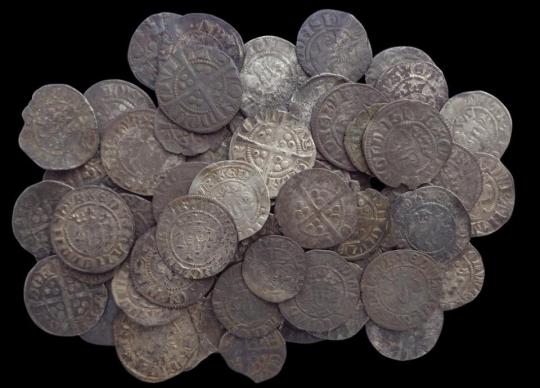

The find was allocated to the National Museums of Scotland and £5,000 was paid out.
Mr Baxter has also found 69 medieval coins from the reign of English King Edward I, whose armies invaded Scotland at the end of the 13th Century.
The medieval ring, which was his first find on the Fife site, dates between the 13th and 14th century.
"Initially I thought it was a bottle top because when it came out of the ground I could see the silver edges," Mr Baxter said.
"I saw the writing at the side and the big clasped hands at the front and I thought: 'That's a medieval ring'.
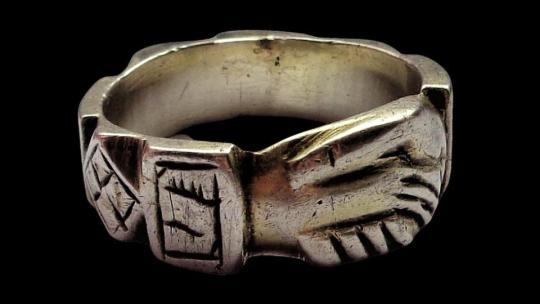
"It was just a great feeling to see it because it was a sunny day and it was twinkling away and it was in really good condition because it's been coated in gold, which has protected it from the soil."
Mr Baxter, who works as a lab technician, said he believed it was a betrothal ring.
"It would have been a higher status individual who owned it," he said.
"It weighs 9.5g, it's a heavy piece. A medieval penny would weigh about 1.2g, so that's about seven medieval pennies, so it wouldn't have been a peasant who owned that at the time."
The ring is silver but it has been coated in gold. It was eight inches down in the ground when his detector picked it up.
Mr Baxter, who has written a book entitled Making history: My Life As a Scottish Metal Detectorist, said it was hard for people to understand how difficult it was to find ancient artefacts.
He said: "In a general field 90% of the time there will be nothing in it.
"You could go in all the fields on the right and left along the M9 from Falkirk to Edinburgh and there would be nothing in them apart from modern Victorian stuff or Georgian stuff.
"It's hard to get stuff that's beyond 500 and 600 years old because the population was a lot lower."
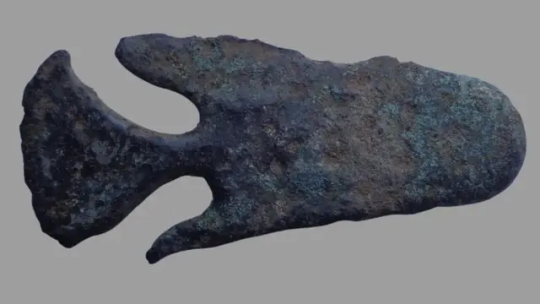
Mr Baxter said a field could be full of medieval items, but detectors were not going to find them if the crops were too high.
"Then it comes down to knowledge and the best conditions," he said.
"You need to know that the crops need to be soft cut.
"Barley and wheat is softer than oats. When oats get cut the stubble is really hard.
"And obviously the carrot harvest was the best."
By Angie Brown.

#Carrot Harvest Helped Metal Detectorist FindA Ancient Coins Hoard#Alan Baxter#Scottish King James III#coin hoard#coin collecting#hoard of farthings#metal detecting#ancient artifacts#archeology#archeolgst#history#history news#ancient history#ancient culture#ancient civilizations#medieval#middle ages#dark ages
51 notes
·
View notes
Text
9,000-year-old rock art discovered among dinosaur footprints in Brazil

As far back as 9,400 years ago, hunter-gatherers in what is now Brazil created dozens of stunning rock-art designs next to the fossilized footprints of dinosaurs, a new study finds.
Researchers described the petroglyphs and dinosaur tracks, which date to the Cretaceous period (145 million to 66 million years ago), in a study published March 19 in the journal Scientific Reports. They think ancient humans purposefully put the rock art next to the dinosaurs' prints, as many of the petroglyphs are a mere 2 to 4 inches (5 to 10 centimeters) from the fossilized marks and some of the glyphs appear to be illustrations of the prints.
"The individuals who crafted the petroglyphs were acutely aware of the footprints, likely selecting the location precisely because of them," study first author Leonardo Troiano, an archaeologist from Brazil's National Institute of Historic and Artistic Heritage, told Live Science "It would have been impossible to overlook their presence."
The archaeological site, known as Serrote do Letreiro (Portuguese for "Signpost Hill"), is about 7 miles (11 kilometers) from the urban center of Sousa municipality in the northeastern state of Paraíba. It's close to the Valley of the Dinosaurs, a conservation area renowned for its hundreds of fossilized dinosaur footprints.
Continue reading.
Tagging @mindblowingscience
#science#history#biology#paleontology#archaeology#brazil#mod nise da silveira#image description in alt
13 notes
·
View notes
Note
I’m wondering if you have any examples of Irish clothing from the early 1600s (around 1610-1615)? I haven’t been able to find much from this era so I’d appreciate any sources or museum collections that you could recommend.
Starting this out with the caveat that if you're looking for the same level of detail and precision that we have for English dress history in this period, you are going to be disappointed. The types of English primary sources we have for this period (well-dated detailed paintings, well-preserved rich-people clothing, wills, printed books, etc) just don't exist for Ireland. There also seems to be much less research interest in 16th-17th c. Irish dress history, so there isn't nearly as much for secondary sources (books, articles etc.).
You don't mention if you are interested in a specific region in Ireland. Ireland in the early 17th c. was a pretty heterogeneous place. People in Dublin and Waterford wore English-influenced styles. According to British-appointed solicitor-general Sir John Davies, by 1606 a few of the wealthier people in Connacht had started wearing English dress, but many others were still wearing Irish clothing. Ulster was a mix of Irish who were wearing Irish dress and incoming English and lowland Scots settlers.
All of the extant Irish clothing I know of from the early 17th c. comes from either bogs or archaeological excavations. It looks like you've already seen my post on extant garments at the NMI. The NMI also has a couple of felt hats that might be early 17th c. This one is from Knockfola, Co. Donegal. It originally had a decorative cord or band where the pale line is:

There are also another cóta mór and brat, found on a bog body from Leigh, Co. Tipperary, which I don't think the NMI has on display. I did not bother to include them in my post, because they are so similar to the ones from Killery, Co. Sligo, but the fact that these have been found in multiple places suggests that they were common, widely-used garments.
The other major garment-find from this period is the Dungiven outfit which is in the Ulster Museum. a short video The bright blue thread was added by a modern conservator; it's not original. (Side note: The identification of this outfit has gotten unfortunately politicized. Tartan trews were worn by both the Irish and the Scots during the 17th century (McClintock 1943, Dunlevy 1989). The presence of tartan should not be used to draw conclusions about the ethnicity of the wearer.) The primary publication for this outfit:
Henshall, Audrey, Seaby, Wilfred A., Lucas, A. T., Smith, A. G., and Connor, A. (1961). The Dungiven Costume. Ulster Journal of Archaeology, 24/25, 119-142. https://www.jstor.org/stable/20627382
The one other reasonably-well preserved outfit that has published on is from a child burial from Emlagh, Co. Kerry, now at University College Cork. Shee and O'Kelly give it a late 17th c date, but they largely base this date on the presence of a rather generic-looking comb. IMO the outfit could easily be early 17th c.

The Emlagh gown, photographed on a living 8-year-old child who was wearing a sweater and skirt underneath. (The 1960s was a different time.)
The bodice has a wrap-front closure with a back and button-up sleeves similar in cut to the Killery cóta mór. The skirt is a pleated rectangle with the pleats sewn in vertically, somewhat like the Shinrone gown. Publication:
Shee, E. and O'Kelly, M. (1966). A Clothed Burial from Emlagh, near Dingle. Journal of the Cork Historical and Archaeological Society, 71(213), 81-91.
There are also, frustratingly, a bunch of fragmentary clothing finds at the NMI which might be 17th c, but no one seems to care enough to do publications on them, and NMI Archaeology still does not have their collection on-line, so they are useless to us.
The typical Irish shoe for this period is known as a brogue (also called a Lucas type 5 by archaeologists). broguesandshoes.com has photos, a pattern, and construction information.
Unfortunately, the illustrations from Speed's map are the only images I know of from this specific period.
If you want details on what materials were used, I recommend Susan Flavin's dissertation. It's about the 16th c. economy, but things didn't change that much between 1599 and 1601. free download here
If you don't mind wading through early modern English and a bit of period-typical prejudice, I recommend reading A Discourse of Ireland, by Luke Gernon written in 1620. His description of Irish clothing starts halfway down p. 356.
Finally, if you can find them, Dress in Ireland by Mairead Dunlevy (1st ed. 1989) and Old Irish and Highland Dress by H. F. McClintock (1st ed. 1943, 2nd ed. 1950) are the best books I know of for this period.
12 notes
·
View notes
Text
It seems that many resources on rabbits mention the domestication of the European rabbit by French monks in 600AD, supposedly as foetal rabbit were considered fish (and therefore could be eaten at lent) by Pope Gregory the Great.
This is however a myth.
It seems Rabbit were domesticated much earlier.
I spent ages tryi g to download the pdf from the research journal Cell Press. Unfortunately it is a charged service. Ironically, the journal entry is open access but Cell Press wants to charge to view?
Thankfully using the OA.mg, which provides open access reasarch journals for free, I was able to find and download from Wayback machine.
The article has been discussed on many news sites aswell.
Here is link to original article-
Here is archive.org link to the pdf-
@lepurcinus
@synapsid-taxonomy
49 notes
·
View notes
Text

VALKNUT REFLECTIONS
Elder Futhark Rune Art 2023
Gifts-of-Heimdall-Runes
●
Valknut Reflections shows a mini project created between February 2023 to May 2023 using Elder Futhark rune circles and Valknut designs.
●
The Valknut is a symbol consisting of three interlocked triangles that appear on a variety of objects from the archaeological record of the ancient Germanic peoples. The term valknut is a modern development; it is not known what term or terms were used to refer to the symbol historically. Scholars have proposed a variety of explanations for the symbol, sometimes associating it with the god Odin.
●
The appearance of the valknut in the archaeological record is highly open to interpretation. The term valknut is a modern Norwegian compound word meaning “knot of those fallen in battle,” referring partly to the theory that the symbol was associated with death (source: Bing AI query, April 2023.)
●
Valknut designs have been featured within my designs since 1987. The design below was on the front of a rune journal (at least until the adhesive died), contrasted by a contemporary version of the 1987 original created by apps, design software in 2023.


●
These pictures were also created using components created whilst making "Textures of Bifröst- Abstract Staves."
●
These pictures were shared as representations of creative journeys over time.
●
Image Ref: VALKNUT images via PNGwing.com
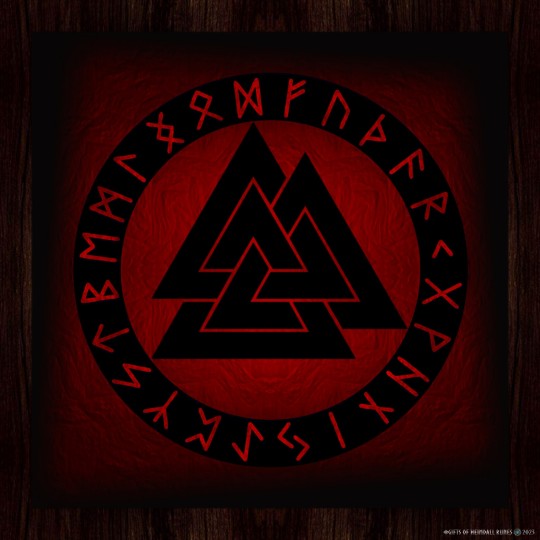
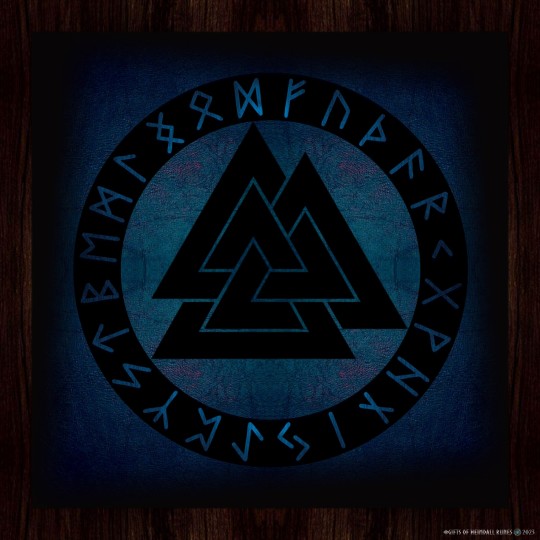
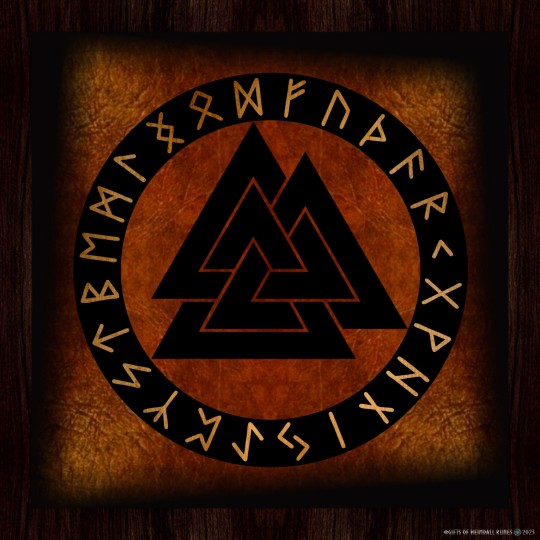


#gifts of heimdall runes#gifts of heimdall#gifts of heimdall rune art#gifts of heimdall art#rune#runes#futhark#elder futhark#elder futhark runes#elder futhark rune art#rune designs#rune art#futhark runes#norse runes#rune circles#heimdall gifts runes#futharkart#norse pagan#valknut#valknut runes#valknut rune art#valknut rune designs
28 notes
·
View notes
Text
[...] things are never innocent beings, they are never just there as simple means towards our ends. [...] We constantly enroll things and charge them with our values and meaning [...]. These inscriptions are successful because things outlive us [...]. Things should, therefore, rather be thought of as ‘political locations’ (Introna, 2009), charged with values, that may be negotiated or even ignored, but are also, because of their [...] durability, somewhat involuntarily re-membered into ever new presents and ever new contexts. We need to be aware of this power of things. That is, we should not rule out the possibility that sometimes ‘... we find what was meant to be found ...’ (Gonzalez-Ruibal, 2011), that Stonehenge isn’t simply any collection of rocks [...].
---
Many people I’ve met [at] the [abandoned early-20th-century Icelandic] herring factories have told me they visit the sites regularly [...] because, they claim, they admire their unruly and ever changing appearance. But what is it that has this effect? [...] Notwithstanding the sites’ historical significance, the ruins left in these northern fjords also become potential agents of disruption and ‘actualization’, triggering a particular kind of involuntary memory [...].
Their presence, an anomaly within the contemporary geopolitical order, bears witness to alternative geographies, other cultural and economic landscapes, to past presences in strange places. A material mnemonic, thus, of a less retrospective and more contemporary social significance; one that calls attention to the fragile dialectics between nature and culture, between [...] centres and peripheries, and, importantly, between heritage and waste. [...] [P]ersisting in this remote and sparsely populated landscape, these untimely ruins silently, but effectively, divert our attention to the perhaps unreconciled tension between the ‘authentic’ Viking and Saga dominated past that roots the nation’s identity and strongly affects its heritage conceptions [...], and the later period of industrialization [...] that provided [...] modernity. [...]
---
Valuing ruination and decay -- how is that heritage management? [...] [T]he answer is simple: it [isn’t]. The traditional idea is that as things or sites become heritage they should, by means of management and conservation, be [...] turned into frozen facts, into stable points of departure [...]. In other words, things are made manageable [...]. But maybe there is room for a different kind of heritage conception, one that is open to the life of things, materiality as dynamic [...].
And is it not possible that valuing ruins as ruins [...] might add to our understanding of things, their temporality and being [...]? The ‘modern’ regime has the tendency to tidily organize our messy being into sealed [...] ontological compartments [...].
What is reassuring of well-managed heritage and properly curated museums is that they provide visitors with an epistemological security by constraining the possibilities of interpreting or encountering things [...]. In ruination that safety net is lost [...].
The undisciplined ruin confronts our customized habit of dealing with things as tame domesticated possessions -- as conventional heritage. The ruin presents itself partly as mystery; things are allowed to be themselves, making their presence more manifest, disquieting [...]. The forms of things are foregrounded: their texture, their smell and their utter silence [...].
---
Text by: Þo ́ra Petursdottir. “Concrete matters: Ruins of modernity and the things called heritage.” Journal of Social Archaeology Volume 13 Issue 1. 2013. [Bold emphasis and some paragraph breaks/contractions added by me.]
#ruins#narrative#nations and states controlling interpretations via knowledge institutions and selective curation#today someone resurrected an older post where i shared most of these same excerpts#and i was reminded of how much i like some of these turns of phrases
62 notes
·
View notes
Text
Puerto Rican Rock Art, Part 2
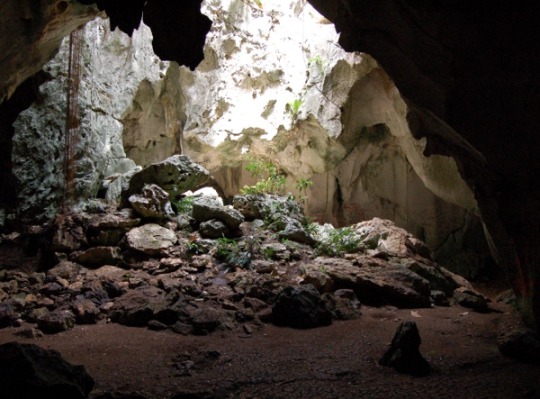
Hello and welcome to part 2 of my Puerto Rican Rock Art project! I will mostly be talking about Cueva Lucero (pictured above). I may mention other caves as well, just because there aren't many papers written about this specific cave. There are many others since about 81% of rock art found on the island is found in caves (Dubelaar 1994). I imagine it's just easier to talk about all the caves as a whole since they were all used similarly.
Cueva Lucero can be found in Juana Diaz in Puerto Rico. (Not from references).

However, due to fears of vandalism, the cave's exact location isn't listed in the National Register of Historic Places. In this same form, Cueva Lucero is deemed as important due to all the art found in it, this art shows us a part of the past we could have never seen without it. It is thought to be a place of religion or as a ceremonial site (Rodriguez et al, 2008). This cave was used around 600-1500 C.E., and represents mostly pre-Hispanic times and contains around 100 rock art images. That makes itself one of the best examples of pictographs in Puerto Rico (Rodriguez et al, 2008). While it has plenty of pictographs, it has petroglyphs as well.
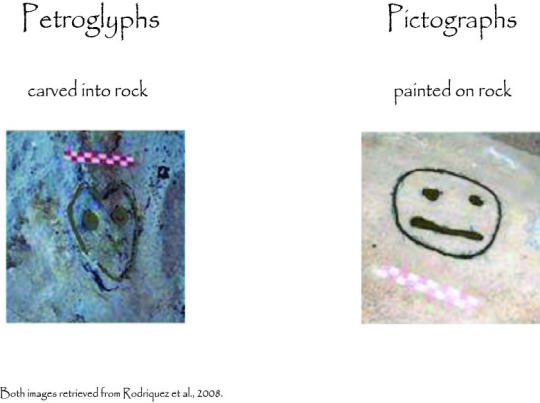
The difference between petroglyphs and pictographs are that one is painted, and one is carved imagery. I included an example above.
There are three different types of landscapes that both these styles show up in:
A. Caves and rock shelters on the coast, created by the waves.
B. Caves and rock shelters found in the mountains.
C. Riverbanks and riverbeds.
As well, Puerto Rico has an extra type:
D. The petroglyphs found in Puerto Nuevo. They are engraved in flat sandstone ledge that run parallel to the coast (Dublelaar 1994). Pictured below.
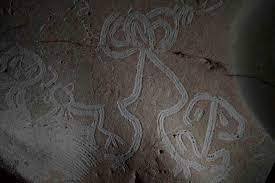

Rock paintings found in Puerto Rico can be monochrome, bichrome and polychrome (Dubelaar 1994). They also can be found in a couple colors as well. Red, white, orange and black were most commonly used (Hayward et. al., 2009).
Cueva Lucero falls under type B, has most, if not, only monochrome paintings. Most are painted using the color black.



Here, you also see a lot of circles being used in their art. Obviously, using circles so much does suggest that the shape has importance for the community (Fewkes 1903). It can be seen as a sign of unity, which, is found in many other indigenous communities. Here are some examples of circle art found in Cueva Lucero.
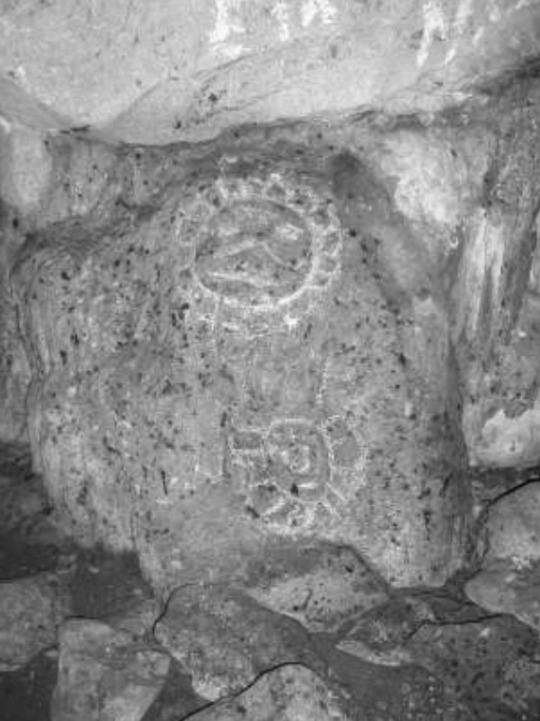




Lots of circles.

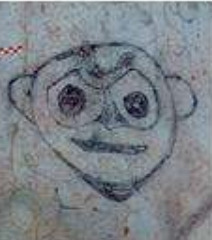
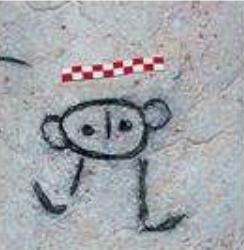
That is about it for this cave. Cueva Lucero holds valuable knowledge about the past. Without it, the other caves, we wouldn't have been able to obtain as much knowledge from our Taino ancestors as we do now. This goes to show, these old paintings and carvings, sites we find on the island (sites where people lived, hunting sites), are vital to understanding our history.
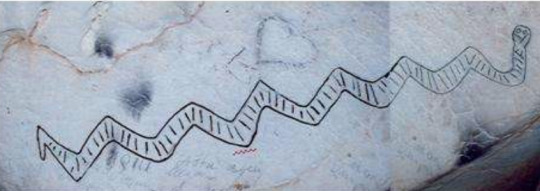
All photos (unless otherwise stated) are pictures from Cueva Lucero. All but the very first photo are from Rodriguez et al. 2008.
My references:
Dubelaar, C. N. 1994. Prehistoric rock art in Puerto Rico. Latin American Indian Literatures Journal, 10(1): 78–82.
Fewkes, J. Walter. “Prehistoric Porto Rican Pictographs.” American Anthropologist 5, no. 3 (1903): 441–67. http://www.jstor.org/stable/659123.
Hayward, M. H., Roe, P. G., Cinquino, M. A., Alvarado Zayas, P. A. and Wild, K. S. 2009. “Rock art of Puerto Rico and the Virgin Islands”. In Rock Art of the Caribbean, Edited by: Hayward, M. H., Atkinson, L. G. and Cinquino, M. A. 115–136. Tuscaloosa: University of Alabama Press.
Lace, Michael J. “Anthropogenic Use, Modification, and Preservation of Coastal Cave Resources in Puerto Rico.” The Journal of Island and Coastal Archaeology, vol. 7, no. 3, 2012, pp. 378–403., https://doi.org/10.1080/15564894.2012.729011.
Rodriguez, Yasha N. and Pedro Alvarado Zayas. 2008. "Cueva Lucero." National Register of Historic Places Registration Form. On file at Puerto Rico State Historic Preservation Office at San Juan, Puerto Rico.
Rouse, I. 1992. The Tainos: Rise and Decline of the People Who Greeted Columbus, New Haven: Yale University.
#archaeology#anthropology#cave#cave art#cave paintings#art#rock art#taino#indigenous peoples#pictographs#petroglyphs#colonialism#colonialization#university#school project#blog#puerto rico#grug#monochrome#mountain#caribbean#circles#frog#bird#references#little guys
29 notes
·
View notes
Text
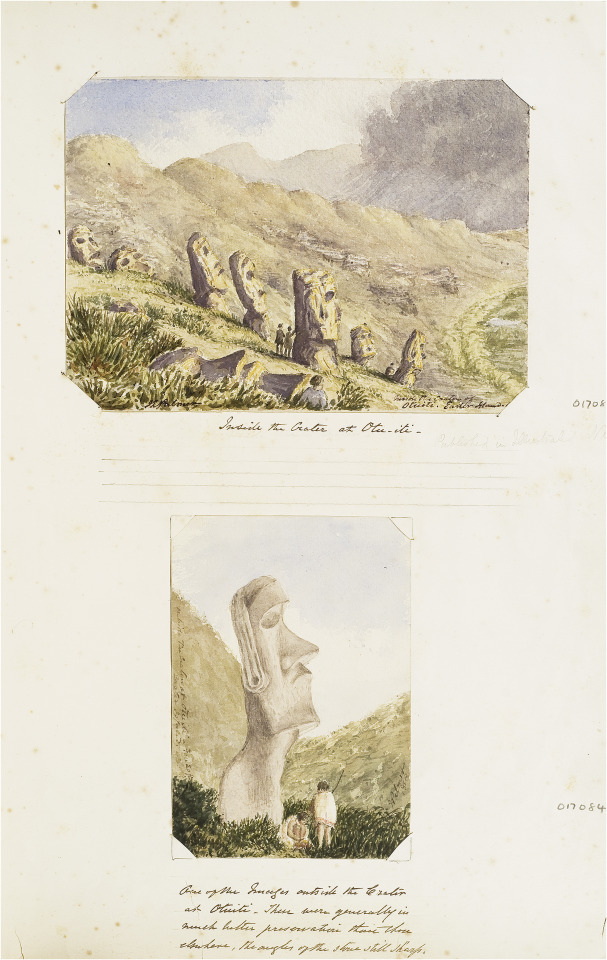
John Linton Palmer, Sketches of moai on Rapa Nui (Easter Island), Nov 1868, watercolour, Easter Island Album, F030/6 © RGS-IBG.
Above: ‘Inside the crater at Otu-iti’ (pencil annotation: ‘Published in Illustrated News’).
Below: ‘One of the images outside the Crater at Otuiti. These were generally in much better preservation than those elsewhere, the angles of the stone still sharp’.
"Linton Palmer’s later sketches indicate an enduring interest in forms of material culture, architecture and archaeology. In 1863, for example, he took leave from HMS Melville to travel for three weeks up-river from Canton with a fellow-doctor William Kane, Scots businessman James Banks Taylor, a missionary Orientalist (and the future Oxford Professor of Chinese) James Legge and his Chinese secretary Tsang Kwei-Hwan. Linton Palmer sketched Buddhist temples and pagodas along the way, although they were not included in a subsequently published account of the trip. Drawing was also to play a significant role in his later studies of the ethnology and geography of Rapa Nui, arising from HMS Topaze’s visit there in November 1868. Although he appears to have included drawings with a letter sent to England the following month, Linton Palmer’s account was published by the Ethnological Society without the drawings, as was another paper presented to the Royal Geographical Society. Nor did his sketches of the skulls (which were sent to Thomas Huxley) appear in print. At least one of his drawings from the Topaze was published in engraved form in the Illustrated London News before his return to London (20 March 1869), and other sketches may have reached wider public audiences in the same way.
...
Today Linton Palmer’s most well-known sketches are those he made on the island of Rapa Nui (Easter island) in 1868, during which one of the moai, Hoa Hakananai’a, was excavated from its underground resting place. The evidential quality of Linton Palmer’s writings on Rapa Nui have been questioned by later archaeologists, especially his supposed tendency to rely on what is regarded as hearsay rather than first-hand observation. However, his sketches of the sites of the moai and the marks upon them constitute a significant and in some respects a unique documentary record which still has value in archaeological study.
...
In view of the continuing debate amongst Rapa Nui specialists over the quality of Linton Palmer’s evidence, it is worth making two further points. The first concerns the place of accurate observation within his routine practice as a naval surgeon: it was his responsibility to observe the bodies of the crew, the condition of the ship and of the weather, and in this context precise documentation in multiple forms was essential. In a naval setting, moreover, the notion of isolated observation independent of ‘hearsay’ does not really make sense: here an observation which was not shared could not be tested or relied upon. The second point concerns Linton Palmer’s prior experience of archaeological survey which has hitherto been unknown. In fact, ten years before the Topaze voyage, Linton Palmer himself had undertaken the first field survey of the stone circle at Calanais (Callanish) in the Hebrides, just prior to its excavation..."
- from Felix Driver, “Material memories of travel: the albums of a Victorian naval surgeon.” Journal of Historical Geography 69 (2020): 48.
#linton palmer#historical geography#art album#royal navy#rapa nui#moai#settler pacific#polynesia#indigenous history#british empire#academic quote#indigenous people#archaeology#archaeological survey
9 notes
·
View notes
Text
Resources for Academic Publishing
This post I made a while back got quite popular. One of the things that showed up often in the tags is "what about paying for academic publishing?"
Basically, the same idea applies. If a journal approaches you and says "hey, we'll publish your article super fast and your just need to pay us this fee," be wary. Academic publishing is slow by design to allow for the peer review process. Predatory journals will take your money and publish your article, but skip the peer review process that makes sure your research is sound. So if you publish with them, not only will you be out a boatload of money, but your integrity as a researcher will be tainted.
That being said, there are many academic journals that do charge fees to publish with them. This article does a good job explaining the different fees that a journal might have.
Since we live in a capitalist society, academic publishers need to make money. To do this, they have to charge the reader and/or the author. Because the potential audience of an academic article is much smaller than the potential audience for, say, the latest vampire romance, publishers by necessity often have to charge authors to publish.
In the rest of this very long post, I'll try my best to give you an overview of ways to publish your research without breaking the bank.
So what's an aspiring academic to do? You are probably not swimming in cash (I just finished grad school, l feel your pain). That's where the magical world of grants comes in. If you are associated with a college or university, see if they offer publication grants. These are often administered through the library, but they can also be available by a department. At my university, the Graduate and Professional Student Association offered quarterly publication grants of up to $1,200 for graduation students to publish their research. There were several funding cycles a year where nobody would apply, which was always sad. There's money out there, if you know where to look!
Also look at professional organizations in your field. Many offer financial assistance to graduate students through grants or fellowships. When you are applying for a grant, make sure to include publishing expenses in your cost breakdown!! This is something that so many people forget to do. And don't just look at the biggest, national/international organizations in your field. There are probably smaller regional organizations that offer funding as well, and they probably aren't as competitive as those national ones.
A pro tip from me is to think outside of the box in terms of what grants/fellowships you apply to. For example, my research focus is the historical archaeology of caves in the southeast US. So I can apply to grants for research in archaeology, caves, history, historical archaeology, cave archaeology, cave history, southeast American history, southeast American archaeology, etc. Look at your research topic and make a list of all of the different umbrellas it can fit under. Then search for organizations that are related to those projects. You might be surprised by what's out there! And if you're unsure if you research topic fits into the scope of a program, it never hurts to send the coordinator a quick email.
Another option is to carefully consider what journals you submit to. A highly prestigious journal is likely to have higher fees than a less prestigious one. As long as your article is peer reviewed, the prestige of a journal is not as important as you might think (The only time is might be important is if you're trying to get tenure).
If you take nothing else from this post, take this: do not self reject! Imposter syndrome is real, and you might feel that you don't deserve funding. That's the devil talking. You, my friend, are an academic badass. Your research is awesome, you're awesome, and you deserve to share your awesomeness with the world. So apply to that grant, even if you don't think you'll get it. You might be surprised.
9 notes
·
View notes